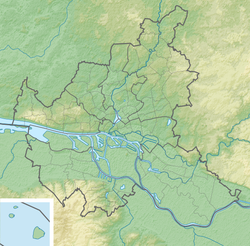| Hamburg Temple | |
|---|---|
German: Israelitischer Tempel | |
 The former synagogue, in 2009 | |
| Religion | |
| Affiliation | Reform Judaism (former) |
| Rite | Nusach Ashkenaz |
| Ecclesiastical or organisational status | |
| Status |
|
| Location | |
| Location | Hamburg: – 1844:
|
| Country | Germany |
Location of the synagogue in Hamburg | |
| Geographic coordinates | 53°34′38″N 9°59′28″E / 53.57733°N 9.99119°E |
| Architecture | |
| Architect(s) | 1844:
|
| Type | Synagogue architecture |
| Style | 1844: 1931: |
| Date established | 11 December 1817 (as a congregation) |
| Groundbreaking |
|
| Completed |
|
| Construction cost | ℛℳ 560,000 (1931) |
| Specifications | |
| Direction of façade |
|
| Capacity | 1,200 (1931) |
| Materials |
|
| [1][2] | |
The Hamburg Temple (German: Israelitischer Tempel) is a former Reform Jewish congregation and synagogue, located in Hamburg, Germany. The congregation was the first permanent Reform Jewish community and the first to have a Reform prayer rite. It operated from 1818 to 1938. On 18 October 1818 the Temple was inaugurated and later twice moved to new edifices, in 1844 and 1931, respectively. The congregation abandoned the synagogue in 1938.
The building has been used as a concert venue since 1949, most recently as the Rolf-Liebermann-Studio, since 2000.
- ^ "Poolstraße (Second) Temple in Hamburg". Historic synagogues of Europe. Foundation for Jewish Heritage and the Center for Jewish Art at the Hebrew University of Jerusalem. n.d. Retrieved July 7, 2024.
- ^ "Oberstraße (Third) Temple in Hamburg". Historic synagogues of Europe. Foundation for Jewish Heritage and the Center for Jewish Art at the Hebrew University of Jerusalem. n.d. Retrieved July 7, 2024.
